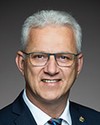Wonderful. Thank you, Madam Chair.
Good evening. I'm happy to be joining you tonight from Ottawa on the unceded traditional land of the Anishinabe Algonquin people.
Thank you for the invitation to participate in this historic study on the state of science in Canada.
First, I'd like to salute the leadership of Dr. Kirsty Duncan in the establishment of this important committee, and to thank all of you for your commitment to this important subject. I am very pleased to be here on behalf of Genome Canada, joined by my colleague Pari Johnston.
Genome Canada is a national, non-profit organization that was created 20 years ago in the shadow of the Human Genome Project. Canada was not a member of the international consortium that completed this historic moonshot achievement. This led a group of Canadian scientists to convince Parliament that Canada risked being left behind and missing the benefits of this exciting new research. They knew that investments in what was then cutting-edge science would be essential for Canada’s future. How right they were.
Genomics has since grown from a discovery science based on sequencing a single genome to a wide-ranging platform technology that has an impact across broad sectors of Canadian society. It drives innovation across precision health and agriculture and the development of novel therapeutics and cutting-edge approaches to forestry, energy and natural resources. We’ve built a national genomics ecosystem that includes six regional genome centres and works with university researchers, hospitals, government scientists and companies, many of which are in your ridings.
In the last 20 years, we've supported over $4 billion in applied research and innovation from coast to coast to coast, with more than half of that coming from private industry, provincial governments and other non-federal sources. We now have strong, world-class genomics researchers, trainees, companies and infrastructure that are leaders on the global stage. We at Genome Canada are deeply committed to a strong science system that will benefit Canada.
Science, especially the life sciences, stepped up in a big way during COVID. In April 2020, with the support of the federal government, Genome Canada launched CanCOGeN, a national network involving universities, public health labs, hospitals and private industry to build a national surveillance system to track viral transmission, the variants of concern and their impact on Canadians. This system has been a cornerstone of our national pandemic response, providing real-time information for public health decision-makers and contributing to a global understanding of the virus.
The Canadian genomics community responded quickly. It was a rapid response 20 years in the making, possible because visionary governments had made prior investments in capacity, talent and infrastructure that could be mobilized quickly to respond to this urgent, shared challenge.
As we emerge from this pandemic, there is no shortage of other urgent, shared challenges. There's climate change, food security, antimicrobial resistance and economic growth. Science can help drive solutions to these challenges, but we need to learn from our COVID experience, so that we have a science system that is up to the task.
What have we learned? First, we've learned that we have immense strengths. We have a diverse and distributed research system built on strong universities and colleges. Our researchers are world-class, and they train thoughtful, ambitious graduates. We have cutting-edge research infrastructure and strength in important technology platforms like genomics, AI and quantum. We also have a committed community of research and policy leaders with a diverse suite of programs to support the ecosystem.
However, we must also be honest about our challenges. Our system is fragmented and often misaligned, and we suffer from persistent coordination challenges in crucial areas like data sharing and research commercialization. We don't have a culture of policy innovation in the research and science space, which is in need of fresh, new approaches. We suffer from chronic underinvestment in R and D by the private sector. Perhaps most importantly, we do not have well-defined national strategic objectives for science.
Many of the ingredients for success are present, but we can't tackle the challenges separately or in isolation. We really need an ecosystem approach.
First, we need strong, stable investment in fundamental research and talent development. This is the base upon which everything rests.
Second, we need coordinated, system-wide approaches that can marshal this research strength into impact, for instance, through mission- or challenge-driven initiatives.
Third, we need strategic leadership to focus our efforts and resources. We need to be honest about where Canada can lead, where we must invest and where we can have the greatest impact. We think a lot about this at Genome Canada. We are seized with the opportunity of our current moment, the beginning of a biorevolution that will fundamentally transform our health, our economy and our environment.
Genome Canada employs a challenge-driven approach to harnessing this potential and ensuring that our capabilities in science generate positive impacts for Canadians. We know this approach will have a positive impact, and we know there are many other examples of great research happening in Canada.
As we come out of the pandemic, we in Canada have an opportunity to refresh our approach and re-energize our science and innovation ecosystem, ensuring that it will benefit all Canadians.
Thank you for your attention.











